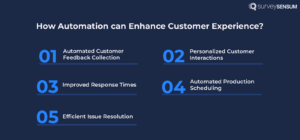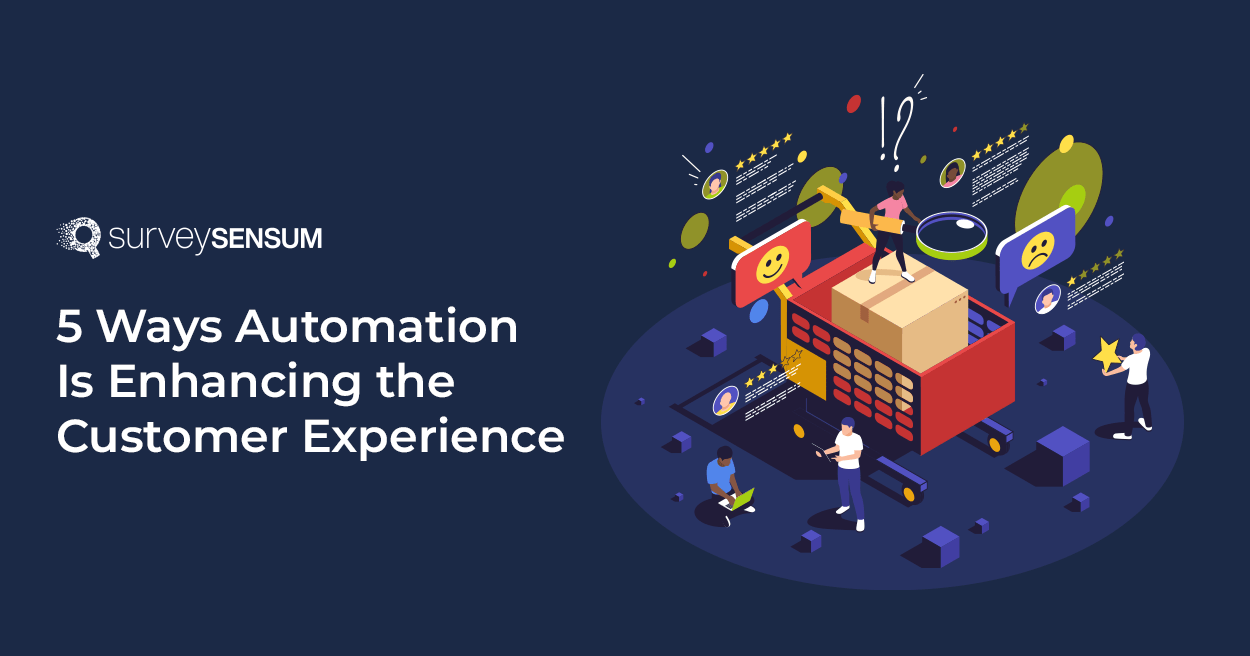
Not so long ago, automation used to be the bugbear of the customer experience. Certainly from the customer’s point of view. Automated helplines that didn’t help and online support that flopped were most people’s encounters.
How times have changed! The advent of AI powered by sophisticated algorithms has transformed mechanization from a customer service hindrance into a potent tool for improving customer satisfaction.
Today, businesses that don’t employ automation risk falling by the wayside. In fact, a recent report by Statista found that 93% of organizations intend (or expect) to leverage automation to enhance the customer experience.
So, let’s explore some of the ways that automation has elevated the standard when it comes to providing an exceptional customer journey.
The Importance of an Enhanced Customer Experience
Customer Experience can be the differentiator for any brand. But to offer exceptional experiences, automation is required.
This is essential for brands to prosper in a competitive landscape where products and services are often similar. In these circumstances, it is the experience that a customer has that can set it apart from the competition.
Implementing automation in customer service is one of the key ways to improve customer effort score. Improving this key metric is essential for lowering customer churn and improving the overall customer journey.
A report published on Statista demonstrates just how much emphasis businesses are placing on an enhanced customer experience.
Among the key takeaways are:
- 44.5% of organizations intend to use AI and automation as a primary competitive differentiator by improving the customer experience.
- A further 48.5% intend to use the same technology as a partial differentiator.
This means that nearly all businesses are looking to automation to improve their CX.
Understanding Automation
Automation can improve customer satisfaction. But, it is worth touching on just what automation is and how it can streamline customer interactions.
Humanizing AI and Automation, in its simplest form, is the use of technology to perform tasks that would traditionally require human intervention. It’s about increasing efficiency, reducing errors, and allowing human resources to focus on tasks that require a personal touch. Automation can also help various specialists, like customer support representatives, software developer recruiters, sales managers, etc., to streamline their routine tasks and boost productivity. A great example of an automation tool is the online booking and scheduling software Calday. The app enables service businesses to manage appointments, schedule meetings, and send automatic reminders to prospects.
Among automation’s numerous productivity solutions, the hotel booking software stands out for helping hotels significantly improve direct bookings and guest satisfaction by streamlining the reservation process and offering personalized guest experiences. Similarly, adventure booking software has revolutionized the adventure tourism industry by providing streamlined booking processes, real-time availability updates, and personalized experiences for adventure enthusiasts. This ensures that both tour operators and customers benefit from a more efficient and enjoyable booking process.
In the context of customer experience, automation takes on an even more significant role. It’s not just about streamlining processes; it’s about enhancing every interaction a customer has with your business. From automated email responses to AI-powered chatbots, automation tools are reshaping the way businesses interact with their customers. For instance, businesses can automate invoices, ensuring that billing is accurate and timely, which reduces disputes and fosters customer trust. Another area where automation is making a significant impact is in law practices. Automation in the legal industry is transforming how law firms operate, from automating the collection of court case data and legal rulings to streamlining client communications and document management.
There is plenty of scope in there for automation to reshape the whole way organizations interact with customers. Let’s take a look at five ways it can do this.
How Automation can Improve Customer Experience – 5 Ways

1. Automated Customer Feedback Collection
Understanding customer feedback is a foundational component of a great customer experience. However, manually collecting and analyzing this feedback can be time-consuming and prone to errors. This is where enterprise automation steps in, ensuring hassle-free creation of a data mart.
The problem that automation helps to resolve is the sheer quantity of data. For instance, businesses operating in the retail sector can gather huge amounts of data. However, interpreting this data manually is time-consuming, costly, and error-prone.
This is where automation can step in and enhance the customer experience for retailers.
Among the features that automated feedback tools are using to revolutionize customer care are:
- Real-time Feedback: Automation allows businesses to collect feedback in real-time, ensuring that they are always up-to-date with their customers’ needs and expectations.
- Comprehensive Data: Automated tools can gather feedback from multiple channels, providing a more comprehensive view of the customer experience.
- Efficient Analysis: Automation can quickly analyze feedback data, identifying trends and patterns that can inform business decisions.
Automated customer feedback is a powerful tool that not only streamlines operations but also significantly enhances the customer experience. For example, you can collect feedback by adding toll-free phone numbers as a way for customers to get in touch with you for free.
2. Personalized Customer Interactions
Personalization is no longer a luxury in customer service; it’s a necessity. Customers today expect businesses to understand their needs and preferences and tailor their interactions accordingly. However, delivering personalized experiences at scale can be a challenge. This is where automation, with the help of a “quantum expert,” comes in. One striking example of quantum technology’s potential impact is the quantum financial system (QFS). This breakthrough system leverages quantum computing’s speed and power to streamline transactions, enhance security, and optimize financial operations, representing a new frontier for finance professionals, tech enthusiasts, and academics alike. Leveraging LinkedIn automation tools can significantly enhance your outreach efforts, ensuring personalized and timely interactions with your professional network.
Automation allows businesses to unlock the power of personalization and use insights to improve customer interactions.
How?
This can take many forms, such as personalized product recommendations, tailored marketing messages, or customized customer service. The use of cold email software in this way would also be an excellent example of automating and personalizing cold email communications.
Here are some key benefits of automated personalization:
- Improved Customer Satisfaction: Personalized interactions make customers feel valued and understood, leading to increased satisfaction and loyalty.
- Increased Sales: Personalized product recommendations and marketing messages can lead to increased sales and revenue.
- Enhanced Customer Engagement: Personalized experiences can enhance customer engagement, leading to stronger customer relationships.
The personalized customer experience was almost washed out of existence as we moved into the digital age. Now AI and automation are re-inventing this critical aspect of the customer experience. Lastly, integrating proposal software, businesses can automate payments ensuring efficiency and accuracy.
Start Sending Customer Surveys With SurveySensum – Sign Up For Free
3. Improved Response Times
Today customers expect quick responses to their inquiries and in some cases, they expect an instant response. One survey published on Statista showed that:
- 20% of customers expect an immediate response to queries raised on social media.
- 28% expected a response within an hour.
- 37% expected a same-day response.
This is where automation can make a significant difference.
Automation can help businesses respond to customer inquiries more quickly and efficiently. For instance, chatbots can provide instant responses to common queries, and automated email responses can ensure that customers receive a response even outside of business hours. Here are some key benefits of improved response times through automation:
- Increased Customer Satisfaction: Quick responses can lead to increased customer satisfaction. Customers appreciate when their time is valued, and a quick response does just that.
- Reduced Customer Churn: By responding quickly to inquiries or complaints, businesses can resolve issues promptly, reducing the likelihood of customers leaving for a competitor.
- Enhanced Reputation: Businesses that are known for their quick response times can enjoy an enhanced reputation, attracting more customers.
Responding timeously to customer queries is simplified through the use of automation.
4. Automated Production Scheduling
Automation is not just enhancing the customer experience on the front end; it’s also revolutionizing operations on the back end. One of the key areas where this is happening is in production scheduling. Automated production scheduling tools help businesses optimize their production processes in several ways:
- Efficient Resource Utilization: These tools ensure resources are used efficiently, reducing waste and saving costs. Using cross-posting software can significantly decrease the manual workload you undertake.
- Timely Order Fulfillment: By optimizing production schedules, these tools ensure that products are delivered on time, leading to improved customer satisfaction.
- Predictive Capabilities: Some advanced tools can even predict future production needs based on trends and historical data, allowing businesses to plan ahead and meet customer demand.
In essence, automated production scheduling is a behind-the-scenes hero, working to enhance the customer experience by ensuring operational efficiency and reliability.
5. Efficient Issue Resolution
With the best will in the world, things will go wrong and customers will have issues. In such cases, a quick response and resolution of customer issues can turn potential PR problems into positive customer experiences.
Here are some of the ways automation can increase the resolution times of customer issues as explained by the offshore web development company professionals:
- Prioritization: Automation can help prioritize issues based on their severity, ensuring critical problems are addressed first.
- Streamlined Processes: Automated workflows can streamline the resolution process, reducing the time it takes to resolve an issue.
- 24/7 Support: With automated support tools like chatbots and other AI tools, customers can get help anytime, leading to improved customer satisfaction.
Automation can add that little bit of lubrication to potential friction points and help achieve a seamless resolution of customer issues. Automation can add that little bit of lubrication to potential friction points even when documenting a business proposal, enabling smoother collaboration and helping achieve a seamless resolution of customer issues.
Automation: Reinventing Customer Care
Automation, powered by AI and sophisticated algorithms, is at the forefront of this revolution. From collecting customer feedback to personalizing interactions, and more, automation is transforming the customer experience.
As businesses continue to leverage these tools, customers can look forward to even more seamless, personalized, and efficient interactions. In essence, automation is not just enhancing the customer experience; it’s redefining it.
Author Bio:
Danny is the forward-thinking CEO of The Digital Warehouse, where he leads with innovation at the core. With a keen eye for industry trends and a drive for excellence, Danny is dedicated to propelling The Digital Warehouse to new heights in the digital era.















